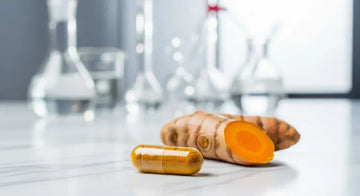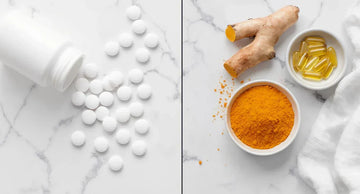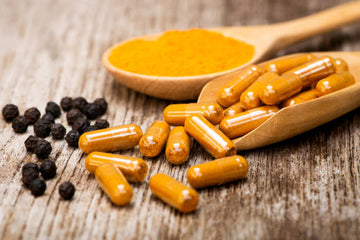You're standing in the supplement aisle, overwhelmed by dozens of turmeric bottles making bold claims. Most contain poorly absorbed curcumin that your body can't use effectively. Some may even pose serious safety risks.
After analyzing comprehensive bioavailability research and reviewing FDA safety warnings, here's exactly what you need to know to choose a turmeric supplement that's both safe and effective.
Table of Contents
The Bioavailability Problem: Why Most Turmeric Supplements Don't Work
The biggest challenge with turmeric supplements isn't quality—it's absorption. A 2021 international review study shows that standard curcumin has extremely poor bioavailability, with most of it eliminated before your body can use it.
The Science: When you take regular curcumin, your liver rapidly metabolizes it through a process called glucuronidation. This means that even high-dose supplements often result in undetectable blood levels.
Bioavailability Enhancement Technologies That Actually Work
Based on 2025 clinical research, here are the proven methods to increase curcumin absorption:
| Technology | Effectiveness | Safety Rating | Our Recommendation |
|---|---|---|---|
| 🥇 Nano Formulations | Human studies typically report 10 – 35 × higher plasma AUC; in vitro or animal work has shown peaks approaching 100 × | ★★★★★ Excellent | RECOMMENDED |
| Phospholipid Complexes | Human trials show 17 – 50% improvements, depending on the specific phospholipid complex (e.g., Meriva®, CurQfen®) | ★★★★☆ Good | Acceptable Alternative |
| ⚠️ Piperine (Black Pepper) | 2000% increase | ★★☆☆☆ Case reports of liver injury exist at high dosages; animal data suggest potential interaction with oral contraceptives—clinical confirmation is limited | USE WITH CAUTION |
Editors' Choice — OurJrney FYC-25 Nano Turmeric
- Patented FYC-25 water-dispersible nano‐curcumin technology.
Human data show a 35 × increase in plasma AUC*. - Produced in an ISO 22000 / HACCP certified facility;
every batch undergoes heavy-metal and potency testing — COAs available on request. - No black-pepper interactions — suitable for long-term use.
*Data on file, independent third-party laboratory report (2024).
Critical Safety Considerations: 2025 FDA Warnings
⚠️ Safety First: Before focusing on efficacy, you must ensure safety. Recent FDA investigations have revealed serious contamination issues in turmeric products.
Heavy Metal Contamination: The Hidden Danger
Monitoring from 2011 – 2024 consistently shows lead-chromate adulteration in some turmeric powders.
Key Findings:
- Multiple turmeric brands recalled between 2013-2017 for excessive lead levels
- FDA Import Alert 99-42 allows detention of turmeric shipments
- Bangladesh and India products show highest contamination rates
Liver Safety Warnings: 2025 Case Reports
New 2025 case studies report serious liver damage linked to turmeric supplements, including a 54-year-old New Jersey man who experienced severe hepatic complications.
The 8-Point Quality Checklist for Turmeric Supplements
Based on clinical research and FDA guidelines, here's your science-based evaluation framework:
✓ 1. Curcuminoid Concentration and Standardization
- Minimum 95% curcuminoids standardization
- Specific breakdown: Curcumin (70-80%), Demethoxycurcumin (15-25%), Bisdemethoxycurcumin (3-15%)
- Avoid products listing only "turmeric powder" without standardization
✓ 2. Bioavailability Enhancement
- BEST: Nano formulations (10 – 35 × in human data; up to 100 × only in certain lab models)
- GOOD: Phospholipid complex technology
- AVOID: Piperine/black pepper (safety concerns)
- Clear labeling of enhancement method
✓ 3. Third-Party Testing and Certificates
- Certificate of Analysis (COA) for each batch
- Testing for heavy metals (lead, mercury, cadmium, arsenic)
- Microbiological safety testing
- Potency verification
✓ 4. Manufacturing Standards
- GMP (Good Manufacturing Practices) certified facility
- FDA-registered facility (in USA)
- ISO 22000 food safety certification
- Organic certification (if claiming organic)
✓ 5. Ingredient Transparency
- Exact curcuminoid content per serving
- All inactive ingredients listed
- Source of turmeric (country/region)
- Extraction method disclosed
✓ 6. Evidence-Based Dosage
- Standard dose: 500-1000mg curcuminoids daily
- Therapeutic dose: Up to 2g daily (with bioavailability enhancer)
- Maximum safe dose: Studies support up to 8g daily short-term
✓ 7. Research and Clinical Evidence
- References to peer-reviewed studies
- Clinical trials on specific formulation
- Clear health claims backed by research
- No exaggerated or unrealistic promises
✓ 8. Price and Value Analysis
- Price range: $20-60 for 60-day supply
- Cost per mg of active curcuminoids
- Inclusion of bioavailability enhancers
- Third-party testing documentation
Brand Categories: Understanding Your Options
Premium Nano Technology Brands
- Characteristics: Advanced nano formulations, enhanced bioavailability, extensive clinical testing, higher price point ($40-80/month)
- Benefits: Superior absorption, reduced interaction potential, improved safety profile
Quality Phospholipid Options
- Characteristics: Standardized 95% curcuminoids, phospholipid enhancement, moderate bioavailability improvement, moderate pricing ($25-45/month)
Budget-Friendly Choices
- Characteristics: Standard curcumin extract, may lack bioavailability enhancers, basic quality testing, lower cost ($10-25/month)
- Note: Budget options can work but require higher doses and careful safety monitoring
Drug Interactions and Safety Warnings
Medications That May Interact:
- Blood thinners: Warfarin, aspirin, clopidogrel
- Diabetes medications: May enhance blood sugar lowering
- Chemotherapy drugs: Can interfere with some treatments
- Immunosuppressants: May enhance or interfere with effects
Who Should Avoid Turmeric Supplements
- Pregnant or breastfeeding women
- People with gallstones or bile duct obstruction
- Those scheduled for surgery (stop 2 weeks prior)
- Individuals with active liver disease
Frequently Asked Questions
Q: How long does it take to see results from turmeric supplements?
A: Clinical studies show that bioavailable formulations can increase blood levels within 45 minutes to 2 hours. However, therapeutic effects for inflammation and pain typically require 4-8 weeks of consistent use.
Q: Can I take turmeric supplements with food?
A: Yes, and it's recommended. Research demonstrates that taking curcumin with fat-containing meals significantly improves absorption, particularly for lipid-based formulations.
Q: Are there any side effects I should watch for?
A: Most people tolerate turmeric supplements well. However, 2025 case reports highlight potential liver concerns with high doses. Stop use and consult a healthcare provider if you experience yellowing of skin/eyes, dark urine, or persistent fatigue.
Q: Should I choose organic turmeric supplements?
A: Organic certification provides additional assurance against pesticide contamination but doesn't guarantee safety from heavy metals. FDA data shows that both organic and conventional products can contain lead contamination. Third-party testing is more important than organic certification.
Q: Is there a real-world product that meets all eight checklist points?
A: One example is OurJrney FYC-25 Nano Turmeric, which ticks every box: GMP manufacturing, batch COAs, nano-dispersion technology, and no piperine-related interactions.
Your Action Plan: Choosing the Right Supplement
Step 1: Assess Your Needs
- Define your health goals
- Consider your budget
- Review any medications or health conditions
- Determine preferred dosage form
Step 2: Research Specific Products
- Use this guide's 8-point checklist
- Request Certificates of Analysis
- Check third-party testing databases
- Read recent customer reviews
Step 3: Start Conservatively
- Begin with lower doses
- Monitor for any adverse effects
- Give 4-8 weeks for evaluation
- Track your response systematically
Step 4: Optimize Your Regimen
- Adjust timing with meals
- Consider bioavailability enhancers
- Evaluate cost-effectiveness
- Reassess goals and results
Conclusion: Making an Informed Choice
Key Takeaways:
- Prioritize nano formulations for superior bioavailability and safety
- Avoid piperine-enhanced products due to emerging safety concerns
- Demand third-party testing for heavy metals and purity
- Verify GMP manufacturing standards and FDA registration
- Start with conservative doses and monitor responses
- Consult healthcare providers for drug interactions
The difference between an effective turmeric supplement and an expensive placebo often comes down to bioavailability technology and quality testing. By following this science-based guide, you'll be equipped to make an informed decision that supports your health goals while prioritizing safety.
Remember: The most advanced nano formulations offer the best combination of effectiveness and safety, making them worth the investment for serious health benefits.







